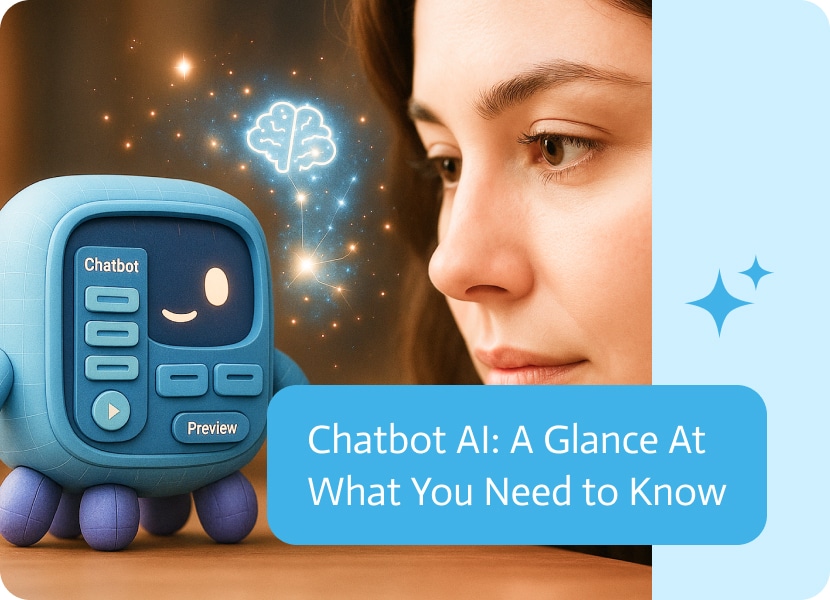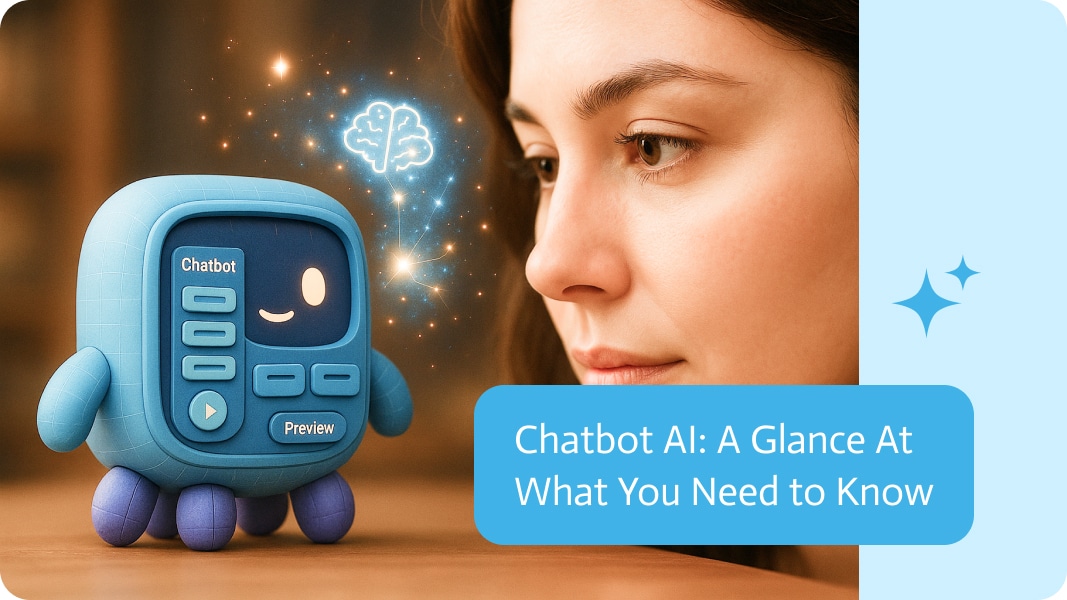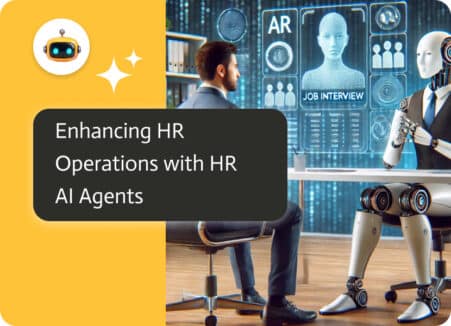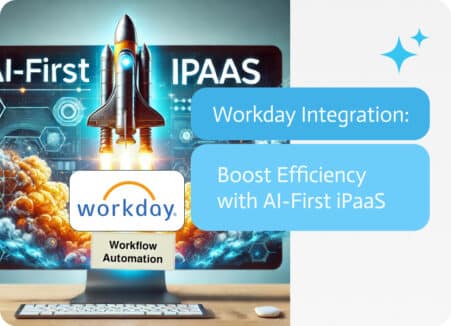

Chatbot AI at a Glance
If you’ve chatted with a website at midnight and got a helpful response in seconds, chances are you weren’t talking to a human; you were talking to an AI chatbot. But what exactly is an AI chatbot, and how is it different from the clunky, scripted bots we used to see a few years ago?
In this guide, we’re breaking down everything you need to know about AI chatbots: what they are, how they work, where they’re used, and why they’re becoming essential for modern businesses.
If you’ve popped onto a website at midnight and gotten a quick, friendly reply, you probably weren’t dealing with a tired customer agent; you were chatting with an AI bot. So what is that sort of bot, and how does it differ from the jerky, preset ones we all remember from a few years back?
What Is an AI Chatbot, Exactly?
An AI chatbot is a piece of software that talks like a person, thanks to artificial intelligence. Old-school bots stuck to strict scripts. AI versions lean on clever tech such as natural language processing (NLP) and machine learning, letting them read between the lines and form answers that feel more human.
These smart bots are built to chat, sure, but their real edge is understanding. They track the drift of a conversation and read the mood, so they grasp what you mean, not just the words you typed. Whether you’re asking about returns, booking a meeting, or fishing for product tips, an AI chatbot decodes the point and shoots back a reply that seems personal.
How AI Chatbots Work
Behind the curtain, the cool stuff happens when computers mix AI models with deep language smarts. When you send a question, the bot quickly tears the sentence apart to figure out what you really need. So when you type, I need to cancel my order, the system knows this is a customer-support issue about order management.
After figuring out the request, the bot dips into its built-in knowledge base, link partners, or simple logic to whip up a useful answer. To make the chat feel natural, it also remembers earlier messages and keeps the same thread going. That way, if you ask, What’s the status of that?, it links that to your order instead of staring blankly.
It’s not just spitting back facts, its actually understanding, reasoning, and then talking to you like a person.
Smarter Than the Old Bots
A huge difference exists between yesterday’s clunky bots and the shiny new AI ones everyone raves about. Classic chat programs were really just fancy menus; they could reply only to set keywords. Change a word or miss a phrase, and they’d throw up their hands figuratively; you’d be stuck.
AI chatbots are much more flexible than older bots. Because they learn from piles of data, they get better over time and can roll with the way people actually talk, think, make typos, use slang, or have mixed-up grammar. That’s the leap from a fixed script to software that feels like it’s thinking on its feet.
Because of this growth, real back-and-forth now feels possible. You can chat with an AI nearly the same way you would with a friendly support rep, and there are times when you almost can’t tell who, or what, you’re dealing with.
Real-World Applications Across Industries
The novelty phase is long gone; AI chatbots are now woven into daily business. In fact, they often end up being the first, and sometimes the only, handshake customers ever get from a company.
In customer support, bots field everything from basic FAQs to simple tech fixes. They clock in around the clock, never complain, and juggle a crowd at once, traits that make them a top pick for any high-volume operation.
E-commerce sites lean on AI like a personal shopper standing by. The bots guide folks to the right item, check where an order is, or toss out fresh suggestions based on shopping history. By turning casual browsing into a quick chat, they spice up the experience and make it feel much more one-of-a-kind.
In hospitals and clinics, chatbots now help people book appointments, send medicine reminders, and even ask basic symptom questions. They don’t take doctors’ jobs, but they do lighten paperwork and make care easier to reach.
You can find the same kind of bot in HR portals, guiding workers through policies or the hiring process, and in schools, tutoring students, suggesting classes, or tracking schedules. It’s amazing how many different tasks one simple tool can handle.
Why Businesses Are Turning to AI Chatbots
The top reason companies are adding AI chatbots is simple: they never sleep. Customers can get help at 3 A.M. or during a lunch break, and the bot is still ready to respond. That around-the-clock support eases pressure on staff and keeps shoppers happy.
Scalability is another big draw. One chatbot can handle hundreds, even thousands, of chats at once, far beyond what anyone on the human team can do. For the business, that means consistent help without the stress and cost of hiring extra agents every time demand spikes.
Speed matters, too. Bots reply almost instantly, so wait times vanish and satisfaction scores go up right away. In fact, a quick answer often nudges a curious visitor further down the sales funnel and boosts conversions almost on the spot.
Personalization brings it all together. Because these programs plug into sales records, catalogs, and website behaviour, they know who is asking and adapt on the fly. That makes the chat feel more natural and less like reading from a script.
What Are the Challenges?
For all their promise, AI chatbots are not a one-size-fits-all fix. They still stumble over clear-cut questions.
Building a really smart chatbot still takes some planning. You have to pick good training data, plug the bot into your other business systems, and say exactly what it can or cannot do. Miss any of those steps, and the bot misreads questions or leaves people annoyed.
Even the best AIs shine at everyday chats, yet they wobble when feelings are mixed in or when a situation is totally new. In those moments, sending the conversation to a real human remains the safest option.
Good news, though: the gap between what bots can do today and what they will handle tomorrow is closing fast.
The Rise of No-Code AI Chatbot Platforms
Right now, the coolest trend is no-code chatbot builders. With these tools, anyone, solopreneur or major brand, can whip up a smart bot without touching code.
Take Noca.ai as a popular example. You just type or speak your request in plain English or any other language for that matter, and the platform figures out the tech details. Need a support bot that plugs into Shopify and strolls customers through returns? Say that, and Noca spins up the workflows, links the apps, and hands you a working bot, ready to chat 24 hours a day.
No-code platforms now let marketers, founders, teachers, and anyone with a good idea build a chatbot without hiring a developer or writing a single line of code.
Conclusion: The Future of Communication
AI chatbots have moved beyond the optional extras bracket. Today, they’re key to how brands talk with customers. By answering questions, guiding sales, and handling basic tasks, they make businesses faster, cheaper, and friendlier while taking some pressure off staff.
As language models improve and drag-and-drop tools get simpler, expect bots to show up in more checkout pages, classrooms, help centers, and virtual offices than ever before.
So, whether you run a local cafe, lead a support team, or simply tinker with gadgets at home, now is the moment to learn what AI chatbots can do for you.
They’re not coming; they’re already on your phone.


